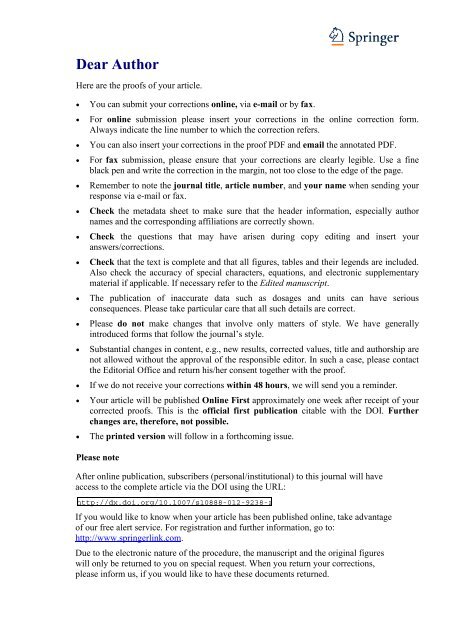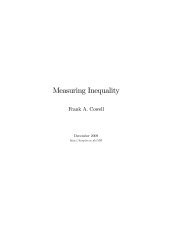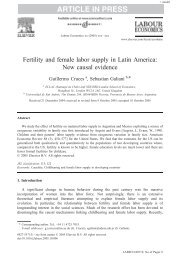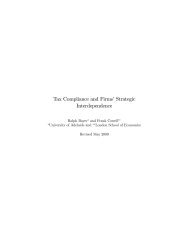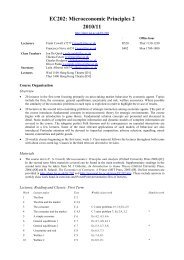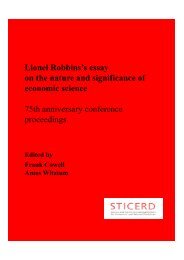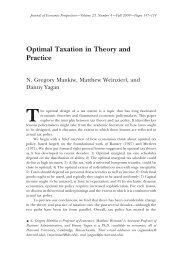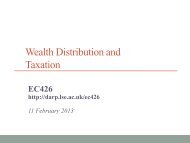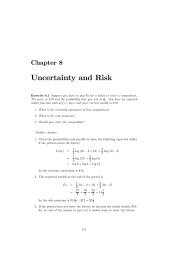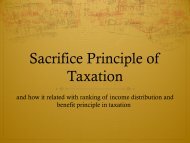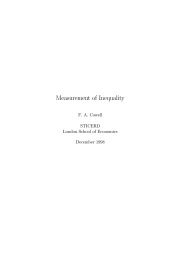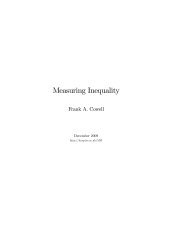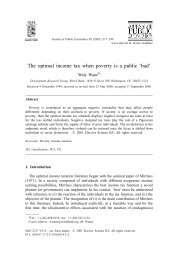author's proof - DARP
author's proof - DARP
author's proof - DARP
Create successful ePaper yourself
Turn your PDF publications into a flip-book with our unique Google optimized e-Paper software.
Dear Author<br />
Here are the <strong>proof</strong>s of your article.<br />
• You can submit your corrections online, via e-mail or by fax.<br />
• For online submission please insert your corrections in the online correction form.<br />
Always indicate the line number to which the correction refers.<br />
• You can also insert your corrections in the <strong>proof</strong> PDF and email the annotated PDF.<br />
• For fax submission, please ensure that your corrections are clearly legible. Use a fine<br />
black pen and write the correction in the margin, not too close to the edge of the page.<br />
• Remember to note the journal title, article number, and your name when sending your<br />
response via e-mail or fax.<br />
• Check the metadata sheet to make sure that the header information, especially author<br />
names and the corresponding affiliations are correctly shown.<br />
• Check the questions that may have arisen during copy editing and insert your<br />
answers/corrections.<br />
• Check that the text is complete and that all figures, tables and their legends are included.<br />
Also check the accuracy of special characters, equations, and electronic supplementary<br />
material if applicable. If necessary refer to the Edited manuscript.<br />
• The publication of inaccurate data such as dosages and units can have serious<br />
consequences. Please take particular care that all such details are correct.<br />
• Please do not make changes that involve only matters of style. We have generally<br />
introduced forms that follow the journal’s style.<br />
• Substantial changes in content, e.g., new results, corrected values, title and authorship are<br />
not allowed without the approval of the responsible editor. In such a case, please contact<br />
the Editorial Office and return his/her consent together with the <strong>proof</strong>.<br />
• If we do not receive your corrections within 48 hours, we will send you a reminder.<br />
• Your article will be published Online First approximately one week after receipt of your<br />
corrected <strong>proof</strong>s. This is the official first publication citable with the DOI. Further<br />
changes are, therefore, not possible.<br />
• The printed version will follow in a forthcoming issue.<br />
Please note<br />
After online publication, subscribers (personal/institutional) to this journal will have<br />
access to the complete article via the DOI using the URL:<br />
http://dx.doi.org/10.1007/s10888-012-9238-z<br />
If you would like to know when your article has been published online, take advantage<br />
of our free alert service. For registration and further information, go to:<br />
http://www.springerlink.com.<br />
Due to the electronic nature of the procedure, the manuscript and the original figures<br />
will only be returned to you on special request. When you return your corrections,<br />
please inform us, if you would like to have these documents returned.
AUTHOR'S PROOF<br />
Metadata of the article that will be visualized in OnlineFirst<br />
_____________________________________________________________________________________<br />
Please note: Images will appear in color online but will be printed in black and white.<br />
_____________________________________________________________________________________<br />
1 Article Title Reference distributions and inequality measurement<br />
2 Article Sub-Title<br />
3 Article Copyright -<br />
Year<br />
Springer Science+Business Media New York 2013<br />
(This will be the copyright line in the final PDF)<br />
4 Journal Name The Journal of Economic Inequality<br />
5<br />
Family Name<br />
6 Particle<br />
Flachaire<br />
7 Given Name Emmanuel<br />
8 Corresponding Suffix<br />
9 Author<br />
Organization Aix-Marseille Université<br />
10 Division Greqam<br />
11 Address 2 rue de la Charité, 13002, Marseille, France<br />
12 e-mail emmanuel.flachaire@univ-cezanne.fr<br />
13<br />
Family Name<br />
14 Particle<br />
Cowell<br />
15 Given Name Frank A.<br />
16 Suffix<br />
Author<br />
17 Organization London School of Economics<br />
18 Division Sticerd<br />
19 Address Houghton Street, London, WC2A 2AE, UK<br />
20 e-mail None<br />
21<br />
Family Name<br />
22 Particle<br />
Bandyopadhyay<br />
23 Given Name Sanghamitra<br />
24 Suffix<br />
Author<br />
25 Organization University of London<br />
26 Division Queen Mary<br />
27 Address Mile End Road, London, E1 4NS, UK<br />
28 e-mail None<br />
29<br />
30 Schedule Revised<br />
Received 3 May 2011<br />
31 Accepted 7 December 2012
AUTHOR'S PROOF<br />
32 Abstract We investigate a general problem of comparing pairs of distribution<br />
which includes approaches to inequality measurement, the<br />
evaluation of “unfair” income inequality, evaluation of inequality<br />
relative to norm incomes, and goodness of fit. We show how to<br />
represent the generic problem simply using (1) a class of<br />
divergence measures derived from a parsimonious set of axioms<br />
and (2) alternative types of “reference distributions.” The problems<br />
of appropriate statistical implementation are discussed and<br />
empirical illustrations of the technique are provided using a variety<br />
of reference distributions.<br />
33 Keywords<br />
separated by ' - '<br />
34 Foot note<br />
information<br />
Divergence measures - Generalised entropy measures - Income<br />
distribution - Inequality measurement - D63 - C10
AUTHOR'S PROOF<br />
J Econ Inequal<br />
DOI 10.1007/s10888-012-9238-z<br />
JrnlID 10888_ArtID 9238_Proof# 1 - 08/01/13<br />
Reference distributions and inequality measurement<br />
Frank A. Cowell · Emmanuel Flachaire ·<br />
Sanghamitra Bandyopadhyay<br />
Received: 3 May 2011 / Accepted: 7 December 2012<br />
© Springer Science+Business Media New York 2013<br />
Abstract We investigate a general problem of comparing pairs of distribution which 1<br />
includes approaches to inequality measurement, the evaluation of “unfair” income 2<br />
inequality, evaluation of inequality relative to norm incomes, and goodness of fit. 3<br />
We show how to represent the generic problem simply using (1) a class of divergence 4<br />
measures derived from a parsimonious set of axioms and (2) alternative types of 5<br />
“reference distributions.” The problems of appropriate statistical implementation 6<br />
are discussed and empirical illustrations of the technique are provided using a variety 7<br />
of reference distributions. 8<br />
Keywords Divergence measures · Generalised entropy measures · 9<br />
Income distribution · Inequality measurement 10<br />
JEL Classification D63 · C10 11<br />
1 Introduction 12<br />
UNCORRECTED PROOF<br />
There is a broad class of problems in distributional analysis that involve comparing 13<br />
two distributions. This may involve judging whether a functional form is a good 14<br />
fit to an empirical distribution; it may involve computation of the divergence of 15<br />
F. A. Cowell Q1<br />
Sticerd, London School of Economics, Houghton Street, London WC2A 2AE, UK<br />
E. Flachaire (B)<br />
Greqam, Aix-Marseille Université, 2 rue de la Charité 13002 Marseille, France<br />
e-mail: emmanuel.flachaire@univ-cezanne.fr<br />
S. Bandyopadhyay<br />
Queen Mary, University of London, Mile End Road, London E1 4NS, UK
AUTHOR'S PROOF<br />
JrnlID 10888_ArtID 9238_Proof# 1 - 08/01/13<br />
F. A. Cowell et al.<br />
16<br />
17<br />
18<br />
19<br />
20<br />
21<br />
22<br />
23<br />
24<br />
25<br />
26<br />
27<br />
28<br />
29<br />
30<br />
31<br />
32<br />
33<br />
34<br />
35<br />
36<br />
37<br />
38<br />
39<br />
40<br />
41<br />
42<br />
43<br />
44<br />
45<br />
46<br />
47<br />
48<br />
49<br />
an empirical distribution from a theoretical economic model; it may involve the<br />
ethical evaluation of an empirical distribution with reference to some norm or ideal<br />
distribution. This paper shows how the class of problems can be characterised in a<br />
way that has a natural interpretation in terms of familiar analytical tools.<br />
This is not some recondite or abstruse topic. Several authors have explicitly<br />
characterised inequality using this two-distribution paradigm: an inequality measure<br />
is defined in terms of the divergence of an empirical income distribution from<br />
an equitable reference distribution [5, 20, 28]. Furthermore several recent papers<br />
have revived interest in the idea of inequality evaluations with reference to “norm<br />
incomes” or a reference distribution; 1 in particular some authors have focused on<br />
replacing a perfectly egalitarian reference distribution with one that takes explicit<br />
account of fairness [3, 19]. In recent contributions Magdalou and Nock [27] have also<br />
examined the concept of divergence between any two income distributions and its<br />
economic interpretation and Cowell et al. [8] show how similar concepts can be used<br />
to formulate an approach to the measurement of goodness of fit. 2<br />
In this paper we use an aprioriapproach to the problem that allows one to<br />
construct a distance concept that is appropriate for characterising the divergence<br />
between the empirical distribution function and a proposed reference distribution.<br />
The approach is related to results in information theory and is adaptable to other<br />
fields in economics that make use of models of distributions [10]. The paper is<br />
structured as follows. Section 2 introduces the concept of divergence and a set of<br />
principles for distributional comparisons in terms of divergence; we show how these<br />
principles characterise a class of measures and discuss different concepts of reference<br />
distribution that are relevant for different versions of the generic problem under<br />
consideration. Section 3 discusses issues of implementation and Section 4 performs<br />
a set of experiments and applications using the proposed measures and UK income<br />
data. Section 5 concludes.<br />
2 The approach<br />
The essence of the problem is the characterisation of the divergence of an income<br />
distribution from a reference distribution: this divergence can be seen as an aggregation<br />
of discrepancies in different parts of the distribution. To fix ideas we<br />
may interpret this in terms of a classic modelling problem: comparing an Empirical<br />
Distribution Function (EDF) ˆF (x) = 1 ∑ n<br />
n+1 i=1 ι (x i ≤ x) 3 and a theoretical reference<br />
distribution F ∗ . For instance, Fig. 1 presents an EDF (dotted line) and a theoretical<br />
UNCORRECTED PROOF<br />
1 Almås et al. [4] compare “actual and equalizing earnings”; their work is related to Paglin’s Gini [29]<br />
and Wertz’s Gini [32]. Also see Jenkins and O’Higgins [25] and Garvy [24].<br />
2 The Cowell et al. [8] approach differs from that developed here in that it deals with the problem of<br />
continuous reference distributions on unbounded support.<br />
3 ι is an indicator function such that ι (S) = 1 if statement S is true and ι (S) = 0 otherwise. We use 1<br />
n+1<br />
rather than 1 n to avoid a problem where i = n. Had we used i n in Eq. 1 then y n would automatically<br />
be set to sup (X) where X is the support of F ∗ .
AUTHOR'S PROOF<br />
Reference distributions and inequality measurement<br />
Fig. 1 Quantile approach<br />
x<br />
JrnlID 10888_ArtID 9238_Proof# 1 - 08/01/13<br />
Q2<br />
Q3<br />
°<br />
°<br />
°<br />
°<br />
Δ x 3<br />
°<br />
x 3 F −1 *<br />
(·)<br />
1<br />
reference distribution (solid line) on a reverse graph, with q denoting proportions 50<br />
of the population on the horizontal axis and the income quantiles on the vertical 51<br />
axis. There are two obvious ways to describe discrepancies between the EDF and the 52<br />
reference distribution: 53<br />
1. The standard approach in the goodness-of-fit literature is based on the “horizon- 54<br />
tal” differences between ˆF (x) and F ∗ (x) for any given x. 55<br />
2. An alternative approach is to compare, for given q values, the corresponding q- 56<br />
quantiles given by the EDF and F ∗ . Denote by {x (1) , x (2) , ..., x (n) } the members 57<br />
of the sample in increasing order; the corresponding values given by the EDF 58<br />
are the adjusted sample proportion q ={ 1<br />
n+1 , 2<br />
n+1 ,..., n<br />
} and, for each q, the 59<br />
n+1<br />
corresponding value for the reference distribution is equal to 60<br />
UNCORRECTED PROOF<br />
y i = F −1<br />
∗<br />
( i<br />
n + 1<br />
)<br />
. (1)<br />
Here we look at the “vertical” differences between the x (i) and y i . As we will 61<br />
see below it is this alternative view that is more fruitful for application to the 62<br />
inequality-measurement problem. 63<br />
2.1 Aggregation of information 64<br />
A divergence measure for the EDF and the reference distribution aggregrates 65<br />
discrepancies between the quantiles of the two distributions, for each value of q. 66<br />
Each discrepancy concerns an income pair (x i , y i )—the ith quantile in the two 67<br />
distributions—and the profile of these pairs captures all the essential information 68<br />
for the problem to which the divergence measure will be applied. We suggest that 69<br />
an appropriate divergence measure should satisfy the following principles: (1) If two 70
AUTHOR'S PROOF<br />
JrnlID 10888_ArtID 9238_Proof# 1 - 08/01/13<br />
F. A. Cowell et al.<br />
71<br />
72<br />
73<br />
74<br />
75<br />
76<br />
77<br />
78<br />
79<br />
80<br />
81<br />
82<br />
83<br />
84<br />
85<br />
86<br />
87<br />
88<br />
89<br />
90<br />
91<br />
92<br />
93<br />
94<br />
95<br />
profiles are equivalent in terms of divergence and the discrepancy for pair i is the<br />
same in each profile, then a local variation at i simultaneously in the two profiles has<br />
no overall effect. (2) If there is zero discrepancy at each of two pairs in the profile<br />
then moving x-income and y-income simultaneously from one pair to the other<br />
has no effect on divergence. (3) Divergence remains unchanged by a uniform scale<br />
change to x-values and y-values simultaneously. (4) Given two discrepancy profiles<br />
with the same aggregate divergence, rescaling all the income discrepancies in each<br />
profile by the same factor results in two new profiles that are equivalent in terms of<br />
divergence. 4<br />
Using the result in Theorem 1 (in the Appendix) and normalising on the case<br />
where both the observed and the reference distribution exhibit complete equality,<br />
these principles gives the following class of measures:<br />
( ) 1<br />
J α x, y :=<br />
nα(α − 1)<br />
[<br />
n∑ [ ] α [ ] ]<br />
1−α xi yi<br />
− 1 . (2)<br />
μ 1 μ 2<br />
i=1<br />
( )<br />
where α takes any real value 5 and J α x, y ≥ 0 for arbitrary x and y. 6 There is an<br />
analogy with the Kullback and Leibler [26] index of relative entropy [10].<br />
So a divergence measure for the EDF and a theoretical reference distribution<br />
(<br />
F ∗<br />
would be given by replacing x i and y i in Eq. 2, respectively, by EDF∗<br />
−1 i<br />
)<br />
n+1 = x(i)<br />
(<br />
and F∗<br />
−1 i<br />
)<br />
:<br />
7<br />
n+1<br />
1<br />
J α =<br />
nα(α − 1)<br />
⎡<br />
n∑<br />
i=1<br />
⎣[<br />
x(i)<br />
] [ α<br />
(<br />
F<br />
−1 i<br />
) ] 1−α<br />
∗ n+1<br />
− 1⎤<br />
⎦ ,α̸= 0, 1. (3)<br />
ˆμ μ (F ∗ )<br />
The J index can be used to measure the divergence between an empirical income<br />
distribution, given by a sample of individual incomes, and any theoretical reference<br />
distribution. It requires the choice of specific values for the parameter α according<br />
to the judgment that one wants to make about the relative importance of different<br />
types of discrepancy: choosing a large positive value for α puts weight on parts of the<br />
distribution where the observed incomes x i greatly exceed the corresponding values<br />
y i in the reference distribution; choosing a substantial negative value puts weight on<br />
cases where the opposite type of discrepancy arises.<br />
UNCORRECTED PROOF<br />
4 SeeAxioms4,5,6,7intheAppendix.<br />
5 ( )<br />
J 0 x, y =−<br />
1 ∑ ( )<br />
ni=1 y i<br />
n μ 2<br />
log xi<br />
μ 1<br />
/ y ( )<br />
i<br />
μ 2<br />
, J 1 x, y =<br />
1 ∑ ( ni=1 x i<br />
n μ 1<br />
log xi<br />
μ 1<br />
/ y i<br />
μ 2<br />
).<br />
6 ( ) ∑<br />
To see this write J α x, y as ni=1 y i<br />
[<br />
nμ 2<br />
ψ (qi ) − ψ (1) ] , where q i := x iμ 2<br />
y i μ 1<br />
,ψ(q) :=<br />
qα<br />
α[α−1] Because<br />
ψ is convex function, for any (q 1 , ..., q n ) and any set of non negative weights (w 1 , ..., w n ) that sum<br />
to 1, ∑ n<br />
i=1 w i ψ (q i ) ≥ ψ (∑ n )<br />
i=1 w i q i . Letting wi = y i / [nμ 2 ] and using the definition of q i we can see<br />
that w i q i = x i / [nμ 1 ] so we have ∑ n<br />
i=1 w i ψ (q i ) ≥ ψ (1) and the result follows. See also [6].<br />
7 The limiting forms are J 0 =−n<br />
1<br />
( ( ))<br />
1 ∑ i<br />
ni=1 x (i)<br />
n ˆμ log x (i)<br />
ˆμ / F−1 ∗ n+1<br />
μ(F ∗) .<br />
(<br />
∑ ni=1<br />
F∗<br />
−1 i<br />
n+1<br />
μ(F ∗)<br />
)<br />
log<br />
(<br />
( ) i<br />
x (i)<br />
ˆμ / F−1 ∗ n+1<br />
μ(F ∗)<br />
)<br />
, J 1 =
AUTHOR'S PROOF<br />
Reference distributions and inequality measurement<br />
JrnlID 10888_ArtID 9238_Proof# 1 - 08/01/13<br />
Q2<br />
Fig. 2 Quantile approach with<br />
the most equal reference<br />
distribution<br />
x<br />
Q3<br />
°<br />
°<br />
°<br />
°<br />
Δ x 3<br />
°<br />
x 3<br />
F −1 *<br />
(·)<br />
1<br />
2.2 Reference distributions 96<br />
The use of the J index also requires the specification of a reference distribution: there 97<br />
are several possibilities. 98<br />
The most equal reference distribution Let us assume that the most equal income 99<br />
distribution is when the same amount is given to each individuals:<br />
100 Q4<br />
( ) i<br />
F∗<br />
−1 =ˆμ for i = 1,...,n (4)<br />
n + 1<br />
If we use this (egalitarian) distribution as the reference distribution in Eq. 3,thenwe 101<br />
find the standard Generalised Entropy inequality measure: 8 102<br />
1<br />
n∑<br />
[( ) α xi<br />
J α =<br />
− 1]<br />
,α̸= 0, 1 (5)<br />
nα(α − 1) ˆμ<br />
UNCORRECTED PROOF<br />
i=1<br />
So the GE inequality measures are divergence measures between the EDF and the 103<br />
most equal distribution, where everybody gets the same income. They tell us how far 104<br />
a distribution is from the most equal distribution. A sample with a smaller index has 105<br />
amoreequal distribution. 106<br />
Figure 2 presents the quantile approach for this case. We can see that the EDF is 107<br />
always above (below) the reference distribution for large (small) values of incomes. 108<br />
It makes clear that large (small) values of α would be more sensitive to changes in 109<br />
high (small) incomes. 110<br />
8 The limiting forms are J 0 =−n 1 ∑ ( )<br />
ni=1<br />
log xi<br />
, J ˆμ 1 = n 1 ∑ ( )<br />
ni=1 x i<br />
ˆμ log xi<br />
. ˆμ
AUTHOR'S PROOF<br />
JrnlID 10888_ArtID 9238_Proof# 1 - 08/01/13<br />
F. A. Cowell et al.<br />
111<br />
112<br />
113<br />
114<br />
115<br />
116<br />
117<br />
118<br />
119<br />
120<br />
121<br />
122<br />
123<br />
124<br />
125<br />
126<br />
127<br />
128<br />
129<br />
130<br />
131<br />
132<br />
133<br />
134<br />
135<br />
136<br />
137<br />
The most unequal reference distribution Rather than selecting the most equal<br />
distribution as a reference distribution, we can reverse the standard approach by<br />
using the most unequal distribution as a reference distribution. The most unequal<br />
income distribution is when one person gets all the income and the others zero:<br />
( ) {<br />
i<br />
F∗<br />
−1<br />
0 for i = 1,...,n − 1<br />
=<br />
n + 1 n ˆμ for i = n<br />
If we use this distribution as the reference distribution in Eq. 3, then we have: 9<br />
[( )<br />
1 max α xi<br />
J α =<br />
− 1]<br />
,α
AUTHOR'S PROOF<br />
Reference distributions and inequality measurement<br />
JrnlID 10888_ArtID 9238_Proof# 1 - 08/01/13<br />
Q2<br />
where 10 138<br />
{<br />
(1 − p)/(1 − k) if i ≤⌈n(1 − k)⌉<br />
c i =<br />
(10)<br />
p/k<br />
if i > ⌈n(1 − k)⌉<br />
There are two interesting special cases. If p = k, everybody gets the same income 139<br />
value, ˆμ, and the reference distribution is the most equal distribution. If k = 1/n and 140<br />
p = 1, only one individual gets all the income, n ˆμ, and the reference distribution is 141<br />
the most unequal distribution. 142<br />
In practice, k and p have to be fixed: (1) to avoid the first drawback, k and p 143<br />
should be independent of the sample size, with k > 1/n and p > 1/n ; (2) to avoid 144<br />
the second drawback, zero incomes are not allowed in the reference distribution, that 145<br />
is, if p = 1 we have k = 1.Finally,tomakeourindexJ α,k,p useful in practice, we need 146<br />
to use constant values, such that 147<br />
1/n < k < 1 and 1/n < p < 1, or p = k = 1. (11)<br />
In empirical studies, we could use several values of k and p. For instance, k = 1 − 148<br />
p = 0.05, 0.01, 0.005, correspond to the reference distributions with the top 5 %, 1 % 149<br />
and 0.5 % getting, respectively, 95 %, 99 % and 99.5 % of the total income. 150<br />
Other reference distributions Clearly, other reference distributions could be used. 151<br />
For instance, if we assume that productive talents are distributed in the population 152 Q4<br />
according to a continuous distribution of talents F ∗ and that wages should be related 153<br />
to talent, a situation in which everyone received the same income to everybody 154<br />
might be considered as unfair. In this case one might use F ∗ as the reference 155<br />
distribution and make use of the index (Eq. 3): any deviation from F ∗ would come 156<br />
from something else than talent. If total income is finite, it makes sense to use 157<br />
a distribution defined on a finite support. For instance, we could use a Uniform 158<br />
distribution or a Beta distribution with two parameters, which can provide a variety 159<br />
of appropriate shapes. 160<br />
3 Implementation 161<br />
UNCORRECTED PROOF<br />
It is necessary to establish the existence of an asymptotic distribution for J α and J α,k,p 162<br />
in order to justify its use in practice. If the most equal distribution is taken as the 163<br />
reference distribution (k = p = 1), the index J α,1,1 is nothing but the standard GE 164<br />
inequality measure, which is asymptotically Normal and has well-known statistical 165<br />
properties. 11 If a continuous distribution is taken as the reference distribution, it can 166<br />
be shown that the limiting distribution of nJ α is that of 167<br />
[ ∫<br />
1 1<br />
B 2 (t)dt<br />
2μ F∗ 0 F∗<br />
−1 (t) f∗ 2(F−1<br />
∗ (t)) − 1 (∫ 1<br />
) 2<br />
]<br />
B(t)dt<br />
μ F∗ 0 f ∗ (F∗<br />
−1<br />
(12)<br />
(t))<br />
10 The limiting forms are J 0,k,p =−n 1 ∑ ( )<br />
ni=1 x(i)<br />
c i log , J c i ˆμ 1,k,p = n<br />
1 ∑ ni=1 x (i)<br />
ˆμ<br />
( )<br />
log<br />
x(i)<br />
. c i ˆμ<br />
11 Among others, see Cowell and Flachaire [9], Davidson and Flachaire [12], Schluter and van<br />
Garderen [31], Schluter [30], Davidson [11].
AUTHOR'S PROOF<br />
JrnlID 10888_ArtID 9238_Proof# 1 - 08/01/13<br />
F. A. Cowell et al.<br />
168 where f ∗ is the density of distribution F ∗ and B(t) is a Brownian bridge. This random<br />
169 variable can have an infinite expectation. It is only if F ∗ has a bounded support<br />
170 that the limiting distribution has reasonable properties—see Cowell et al. [8] and<br />
171 Davidson [11] for more details. If we use a continuous parametric reference distri-<br />
172 bution, since total income is finite, it makes sense to use a distribution F ∗ defined<br />
173 on a bounded support only. For instance, one could use a Uniform distribution or<br />
174 a Beta distribution with two parameters, which can provide many different shapes.<br />
175 The same approach can be used for nJ α,k,p , noting that the last statistic is equivalent<br />
176 to the statistic defined in (9) in Cowell et al. [8], where 2i/(n + 1) is replaced by c i<br />
177 defined in Eq. 10.<br />
178 In the two cases, the limiting distribution of J α and J α,k,p exists, but is not<br />
179 tractable. This is enough to justify the use of bootstrap methods for making inference.<br />
180 To compute a bootstrap confidence interval, we generate B bootstrap samples by<br />
181 resampling from the original data, and then, for each resample, we compute the<br />
182 index J. We obtain B bootstrap statistics, Jα b , b = 1,...,B. The percentile bootstrap<br />
183 confidence interval is equal to<br />
CI perc = [ c b 0.025 ; ]<br />
cb 0.975<br />
(13)<br />
184 where c b 0.025 and cb 0.975<br />
are the 2.5 and 97.5 percentiles of the EDF of the bootstrap<br />
185 statistics—for a comprehensive discussion on bootstrap methods, see Davison and<br />
186 Hinkley [17], Davidson and MacKinnon [15]. For well-known reasons [14, 17] the<br />
187 number B should be chosen so that (B + 1)/100 is an integer: here we set B = 999<br />
188 unless otherwise stated.<br />
189 To be used in practice, we need to determine the finite sample properties of J α<br />
190 and J α,k,p . The coverage error rate of a confidence interval is the probability that<br />
191 the random interval does not cover the true value of the parameter. A method of<br />
192 constructing confidence intervals with good finite sample properties should generate<br />
193 a coverage error rate close to the nominal rate. For a confidence interval at 95 %,<br />
194 the nominal coverage error rate is equal to 5 %. We use Monte-Carlo simulation<br />
195 to approximate the coverage error rate bootstrap confidence intervals in several<br />
196 experimental designs.<br />
197 In our experiments, samples are drawn from a lognormal distribution. For fixed<br />
198 values of α, k, p and n, we draw 10,000 samples. For each sample we compute J α or<br />
199 J α,k,p and its confidence interval at 95 %. The coverage error rate is computed as<br />
200 the proportion of times the true value of the inequality measure is not included in<br />
201 the confidence intervals. 12 Confidence intervals perform well in finite samples if the<br />
202 coverage error rate is close to the nominal value, 0.05.Table1 presents the coverage<br />
203 error rate of bootstrap confidence intervals at 95 % of J α and J α,k,p for several<br />
204 reference distributions. The standard GE measures use the most equal reference<br />
205 distribution, it corresponds to J α,1,1 .When“thetop1%richestgets99%ofthe<br />
206 income” is the reference distribution we use the index J α,0.01,0.99 ; when “the top<br />
207 5 % richest gets 99 % of the income” is the reference distribution we use J α,0.05,0.99 .<br />
208 In addition, we examine J α with two continuous (bounded) parametric reference<br />
209 distributions, the Beta(1,1) distribution which is equal to the Uniform(0,1), and the<br />
UNCORRECTED PROOF<br />
12 The true values are computed replacing x (i) in Eq. 3 by F −1 ( n+1 i ),whereF is the distribution of x,<br />
that is, the lognormal distribution in our experiments.
AUTHOR'S PROOF<br />
Reference distributions and inequality measurement<br />
JrnlID 10888_ArtID 9238_Proof# 1 - 08/01/13<br />
Q2<br />
Q5 t1.1 Table 1 Coverage error rate of bootstrap confidence intervals at 95 % of J α and J α,k,p , 10,000<br />
replications, 499 bootstraps, and x ∼ Lognormal(0, 1)<br />
t1.2 α −1 0 0.5 1 2<br />
Equal reference distribution<br />
Standard GE measures (k = p = 1)<br />
t1.3 n = 100 0.0753 0.0734 0.0832 0.0912 0.1166<br />
t1.4 n = 200 0.0747 0.0667 0.0713 0.0785 0.1024<br />
t1.5 n = 500 0.0669 0.0673 0.0716 0.0781 0.0983<br />
t1.6 n = 1000 0.0658 0.0606 0.0642 0.0709 0.0878<br />
t1.7 n = 2000 0.0567 0.0565 0.0620 0.0658 0.0831<br />
t1.8 n = 5000 0.0557 0.0562 0.0606 0.0672 0.0809<br />
Unequal reference distributions<br />
Top 5 % gets 99 % of the income (k = 0.05, p = 0.99)<br />
t1.9 n = 100 0.0722 0.0887 0.0983 0.1005 0.0395<br />
t1.10 n = 200 0.0597 0.0662 0.0733 0.0813 0.0482<br />
t1.11 n = 500 0.0594 0.0577 0.0638 0.0681 0.0584<br />
t1.12 n = 1000 0.0553 0.0543 0.0572 0.0619 0.0575<br />
t1.13 n = 2000 0.0581 0.0557 0.0552 0.0590 0.0564<br />
t1.14 n = 5000 0.0526 0.0531 0.0562 0.0588 0.0569<br />
Top 1 % gets 99 % of the income (k = 0.01, p = 0.99)<br />
t1.15 n = 100 0.2220 0.2221 0.2172 0.1347 0.0325<br />
t1.16 n = 200 0.1601 0.1689 0.1705 0.1265 0.0275<br />
t1.17 n = 500 0.0998 0.1117 0.1188 0.1064 0.0346<br />
t1.18 n = 1000 0.0703 0.0788 0.0867 0.0878 0.0422<br />
t1.19 n = 2000 0.0581 0.0642 0.0682 0.0717 0.0486<br />
t1.20 n = 5000 0.0558 0.0598 0.0616 0.0627 0.0504<br />
Continuous reference distributions<br />
Beta(1,1)<br />
t1.21 n = 100 0.0830 0.0877 0.0923 0.0981 0.1162<br />
t1.22 n = 200 0.0703 0.0756 0.0805 0.0865 0.1029<br />
t1.23 n = 500 0.0689 0.0740 0.0778 0.0847 0.1011<br />
t1.24 n = 1000 0.0650 0.0674 0.0710 0.0766 0.0905<br />
t1.25 n = 2000 0.0605 0.0632 0.0645 0.0700 0.0838<br />
t1.26 n = 5000 0.0623 0.0638 0.0660 0.0715 0.0824<br />
Beta(2,2)<br />
t1.27 n = 100 0.0778 0.0841 0.0896 0.0945 0.1122<br />
t1.28 n = 200 0.0680 0.0730 0.0764 0.0832 0.1002<br />
t1.29 n = 500 0.0694 0.0722 0.0762 0.0829 0.0988<br />
t1.30 n = 1000 0.0611 0.0656 0.0682 0.0742 0.0885<br />
t1.31 n = 2000 0.0574 0.0626 0.0636 0.0679 0.0834<br />
t1.32 n = 5000 0.0584 0.0632 0.0651 0.0694 0.0816<br />
UNCORRECTED PROOF<br />
Beta(2,2) which is a symmetric inverted-U-shape distribution. Table 1 shows that 210<br />
the finite sample properties of the indices with alternative reference distributions are 211<br />
not very diferent from those of the standard GE measures, except for J α,0.01,0.99 when 212<br />
n ≤ 500. The coverage error rate is close to 0.05 for very large samples. For small 213<br />
and moderate samples, further investigation is required to improve the finite sample 214<br />
properties, with, for instance, a fast double or triple bootstrap [13, 16]. 215
AUTHOR'S PROOF<br />
JrnlID 10888_ArtID 9238_Proof# 1 - 08/01/13<br />
F. A. Cowell et al.<br />
216<br />
217<br />
218<br />
219<br />
220<br />
4 Application<br />
Let us compare the performance of J α,k,p with that of conventional GE inequality<br />
measures using UK income data as a case study. 13 Table 2 presents the results of<br />
indices J α and J α,k,p estimated with three different types of reference distribution,<br />
along with bootstrap confidence intervals at 95 %.<br />
221<br />
222<br />
223<br />
224<br />
225<br />
226<br />
227<br />
228<br />
229<br />
230<br />
231<br />
232<br />
233<br />
234<br />
235<br />
236<br />
237<br />
238<br />
239<br />
240<br />
241<br />
242<br />
243<br />
244<br />
245<br />
246<br />
247<br />
248<br />
249<br />
250<br />
251<br />
252<br />
Equality The top panel of Table 2 presents estimates of J α,k,p using an “equality” Q4<br />
reference distribution. Clearly, when we select the most equal distribution as the<br />
reference distribution, i.e. k = p = 1, the index J α,k,p is reduced to the standard GE<br />
inequality measure. Estimates for standard GE measures, J α,1,1 are tabulated in the<br />
first row, for values of α ranging from −1 to 2. 14 When α = 1, J α,1,1 is the Theil<br />
index. For values of α = 0.5, 1, 1.5, 2, J α,1,1 represents transformed Atkinson indices<br />
[7]. All estimates of standard GE measures increase considerably between 1979 and<br />
1988, suggesting a significant rise in inequality in the 80s.<br />
Extreme inequality The key point highlighted earlier was that changing the refer- Q4<br />
ence distribution from which we measure the distance of the empirical distribution<br />
opens up the possibility for researchers to choose the exact distribution from which<br />
they wish to measure distance of the empirical distribution. While standard GE<br />
indices tell us about the distance of the empirical distribution from an equal reference<br />
distribution, one can change the focus to that of its distance from an unequal<br />
reference distribution. The second panel of Table 2 presents estimates of J α,k,p using<br />
several “extreme inequality” reference distributions. The interpretation of the size<br />
of the J α,k,p index now is the reverse of the interpretation of standard GE measures.<br />
For a standard GE inequality measure, a small value of J α,1,1 corresponds to the<br />
empirical distribution being close to the equal reference distribution compared to<br />
that of a large value of J α,1,1 . However, for an unequal reference distribution a small<br />
value of J α,k,p corresponds to the empirical distribution being close to the particular<br />
“extreme inequality” reference distribution that has been specified.<br />
To illustrate we focus on two different unequal reference distributions: one, where<br />
the top 1 % of the income distribution receive 99 % of the income, and second,<br />
where the top 5 % of the income distribution receive 99 % of the income. From<br />
Table 2 we can see that, with one exception, the values of J α,k,p have dropped<br />
between years 1979 and 1988: in other words, it is almost always true that the distance<br />
from the “extreme inequality” reference distribution has decreased. The exception<br />
is the case (k = 0.05, p = 0.99,α = 2) where the movement relative to the reference<br />
distribution is not significant. The implication is that UK inequality grew during the<br />
1980s whether one interprets this in terms of distance from equality, or as distance<br />
from a reference unequal distribution, except for one case. This case concerns top-<br />
UNCORRECTED PROOF<br />
13 The application uses the “before housing costs” income variable of the Family Expenditure Survey<br />
for years 1979 and 1988 [18], deflated and equivalised using the McClements adult-equivalence<br />
scale. We exclude households with self-employed individuals as reported incomes are known to be<br />
misrepresented. The years 1979 and 1988 have been chosen to represent the maximum recorded<br />
difference in inequality across the available years, post-1975.<br />
14 A large value of α implies greater weight on parts of the distribution where the observed incomes<br />
are vastly different from the corresponding values in the reference distribution.
AUTHOR'S PROOF<br />
Reference distributions and inequality measurement<br />
JrnlID 10888_ArtID 9238_Proof# 1 - 08/01/13<br />
Q2<br />
Q5 t2.1 Table 2 Inequality indices Jα,k,p and Jα computed with different reference distributions<br />
t2.2 α −1 0 0.5 1 2<br />
Equal reference distribution<br />
Standard GE measures (k = p = 1)<br />
t2.3 1979 0.1218 0.1056 0.1046 0.1066 0.1201<br />
t2.4 [0.1119;0.1355] [0.1016;0.1097] [0.1005;0.1086] [0.1023;0.1111] [0.1132;0.1271]<br />
t2.5 1988 0.1836 0.1541 0.1543 0.1618 0.2096<br />
t2.6 [0.1685;0.2018] [0.1468;0.1613] [0.1460;0.1634] [0.1508;0.1728] [0.1843;0.2381]<br />
Unequal reference distributions<br />
Top 1 % gets 99 % of the income (k = 0.01, p = 0.99)<br />
t2.7 1979 15.29 3.370 2.906 4.403 55.39<br />
t2.8 [14.46;16.21] [3.315;3.427] [2.887;2.926] [4.390;4.419] [55.05;55.75]<br />
t2.9 1988 11.70 3.086 2.795 4.341 57.97<br />
t2.10 [10.59;12.792] [2.982;3.182] [2.749;2.836] [4.300;4.378] [57.32;58.66]<br />
Top 5 % gets 99 % of the income (k = 0.05, p = 0.99)<br />
t2.11 1979 3.803 2.080 2.271 3.768 44.43<br />
t2.12 [3.708;3.907] [2.057;2.106] [2.254;2.288] [3.747;3.789] [44.08;44.74]<br />
t2.13 1988 3.194 1.915 2.151 3.631 44.14<br />
t2.14 [3.088;3.293] [1.882;1.945] [2.123;2.175] [3.591;3.665] [43.47;44.73]<br />
Continuous reference distributions<br />
Beta(1,1) or Uniform(0,1)<br />
t2.15 1979 0.0320 0.0406 0.0483 0.0613 0.1457<br />
t2.16 [0.0308;0.0333] [0.0391;0.0421] [0.0465;0.0501] [0.0589;0.0638] [0.1311;0.1648]<br />
t2.17 1988 0.0339 0.0418 0.0486 0.0591 0.1125<br />
t2.18 [0.0313;0.0373] [0.0383;0.0461] [0.0444;0.0536] [0.0538;0.0655] [0.1014;0.1276]<br />
UNCORRECTED PROOF
AUTHOR'S PROOF<br />
JrnlID 10888_ArtID 9238_Proof# 1 - 08/01/13<br />
F. A. Cowell et al.<br />
UNCORRECTED PROOF<br />
Q5 t2.1 Table 2 (continued)<br />
t2.2 α −1 0 0.5 1 2<br />
Beta(2,2)<br />
t2.3 1979 0.0115 0.0132 0.0143 0.0158 0.0199<br />
t2.4 [0.0105;0.0127] [0.0121;0.0146] [0.0131;0.0158] [0.0144;0.0175] [0.0181;0.0222]<br />
t2.5 1988 0.0210 0.0243 0.0267 0.0299 0.0405<br />
t2.6 [0.0180;0.0242] [0.0204;0.0283] [0.0221;0.0316] [0.0242;0.0362] [0.0300;0.0524]<br />
Beta(2,5)<br />
t2.7 1979 0.0116 0.0138 0.0153 0.0173 0.0237<br />
t2.8 [0.0109;0.0124] [0.0129;0.0147] [0.0143;0.0163] [0.0162;0.0185] [0.0219;0.0256]<br />
t2.9 1988 0.0121 0.0142 0.0157 0.0175 0.0231<br />
t2.10 [0.0100;0.0145] [0.0116;0.0172] [0.0127;0.0192] [0.0141;0.0217] [0.0177;0.0294]<br />
t2.11 Data are from the Family Expenditures Surveys in UK. Bootstrap confidence intervals at 95 % are given in brackets
AUTHOR'S PROOF<br />
Reference distributions and inequality measurement<br />
JrnlID 10888_ArtID 9238_Proof# 1 - 08/01/13<br />
Q2<br />
sensitive inequality where, in terms of “distance from maximum inequality,” the 253<br />
change in the distribution is inconclusive. 254<br />
Theoretical distribution Finally let us consider how inequality changed using a con- 255 Q4<br />
tinuous reference distribution F ∗ . The last panel of Table 2 tabulates the results for 256<br />
three F ∗ from the Beta distribution family. Did UK income inequality, interpreted 257<br />
as a distance from a Beta-family reference distribution increase We can see that 258<br />
the values of J α are not statistically different between 1979 and 1988 when the 259<br />
Beta(1,1) (uniform) or Beta(2,5) (unimodal, right skewed) is used as the reference 260<br />
distribution distribution, while they are statistically different when the Beta(2, 2) 261<br />
(unimodal symmetric) is used as the reference distribution. 262<br />
The estimates of the standard GE inequality measures J α,1,1 and of those of J α,k,p 263<br />
and J α in Table 2 provide us with different information about divergence of the 264<br />
empirical distribution from the chosen reference distribution. By varying the values 265<br />
of k and p, one can specify the exact skewness of the reference distribution one would 266<br />
like to measure distance of the empirical distribution from. Likewise, by varying the 267<br />
values of α one can focus on different parts of the income distribution. A large value 268<br />
of α implies a greater weight on parts of the distribution where the observed incomes 269<br />
are vastly different from the corresponding values in the reference distribution. 270<br />
Finally, one can choose specific parametric distributions which correspond to the 271<br />
relevant reference distribution that the researcher is interested in. 272<br />
5 Conclusion 273<br />
The problem of comparing pairs of distributions is a widespread one in distributional 274<br />
analysis. It is often treated on an ad-hoc basis by invoking the concept of norm 275<br />
incomes and an arbitrary inequality index. 276<br />
Our approach to the issue is a natural generalisation of the concept of inequal- 277<br />
ity indices where the implicit reference distribution is the trivial perfect-equality 278<br />
distribution. Its intuitive appeal is supported by the type of axiomatisation that 279<br />
is common in modern approaches to inequality measurement and other welfare 280<br />
criteria. The axiomatisation yields indices that can be interpreted as measures of 281<br />
divergence and are related to the concept of divergence entropy in information 282<br />
theory [10]. Furthermore, they offer a degree of control to the researcher in that 283<br />
the J α indices form a class of measures that can be calibrated to suit the nature of the 284<br />
economic problem under consideration. Members of the class have a distributional 285<br />
interpretation that is close to members of the well-known generalised-entropy class 286<br />
of inequality indices. 287<br />
In effect the user of the J α -index is presented with two key questions: 288<br />
UNCORRECTED PROOF<br />
1. the income discrepancies underlying inequality are with reference to what 289<br />
2. to what kind of discrepancies do you want the measure to be particularly 290<br />
sensitive 291<br />
As our empirical illustration has shown, different responses to these two key ques- 292<br />
tions provide different interpretations from the same set of facts. 293
AUTHOR'S PROOF<br />
JrnlID 10888_ArtID 9238_Proof# 1 - 08/01/13<br />
F. A. Cowell et al.<br />
294<br />
Appendix: Axiomatic foundation<br />
295 For convenience we work with z :=(z 1 , z 2 , ..., z n ), where each z i is the ordered pair<br />
296 (x i , y i ), i = 1, ..., n and belongs to a set Z , which we will take to be a connected<br />
297 subset of R + × R + . For any z ∈ Z n denote by z (ζ,i) the member of Z n formed<br />
298 by replacing the ith component of z by ζ ∈ Z . The divergence issue focuses on the<br />
299 discrepancies between the x-values and the y-values. To capture this introduce a<br />
300 discrepancy function d : Z → R such that d (z i ) is strictly increasing in |x i − y i |.The<br />
301 solution is in two steps: (1) characterise a weak ordering ≽ on Z n (z ≽ z ′ means “the<br />
302 income pairs in z are at least as close according to ≽ as the income pairs in z ′ ”) (2)<br />
303 use the function representing ≽ to generate the index J.<br />
304<br />
Axiom 1 (Continuity) ≽ is continuous on Z n .<br />
305 Axiom 2 (Monotonicity) If z, z ′ ∈ Z n differ only in their ith component then<br />
d (x i , y i ) < d ( 306<br />
x<br />
i ′, i) y′ ⇐⇒ z ≻ z ′ .<br />
307 Axiom 3 (Symmetry) For any z, z ′ ∈ Z n such that z ′ is obtained by permuting the<br />
308 components of z: z ∼ z ′ .<br />
309 Axiom 3 implies that we may order the components of z such that x 1 ≤ x 2 ≤ ... ≤<br />
310 x n and y 1 ≤ y 2 ≤ ... ≤ y n .<br />
311 Axiom 4 (Independence) For z, z ′ ∈ Z n such that: z ∼ z ′ and z i = z<br />
i ′ for some i then<br />
z (ζ,i) ∼ z ′ (ζ,i) for all ζ ∈ [ ] [ ]<br />
312 z i−1 , z i+1 ∩ z<br />
′<br />
i−1<br />
, z<br />
i+1<br />
′ .<br />
313 Axiom 5 (Zero local discrepancy) Let z, z ′ ∈ Z n be such that, for some i and j, x i =<br />
314 y i , x j = y j , x<br />
i ′ = x i + δ, y<br />
i ′ = y i + δ, x ′ j = x j − δ, y ′ j = y j − δ and, for all k ̸= i, j, x ′ k =<br />
315 x k , y ′ k = y k.Thenz ∼ z ′ .<br />
316 Axiom 6 (Income scale irrelevance) For any z, z ′ ∈ Z n such that z ∼ z ′ , tz ∼ tz ′ for<br />
317 all t > 0.<br />
UNCORRECTED PROOF<br />
318 Axiom 7 (Discrepancy scale irrelevance) Suppose there are z 0 , z ′ 0 ∈ Z n such that<br />
z 0 ∼ z ′ 0 . Then for all t > 0 and z, z′ such that d (z) = td (z 0 ) and d ( z ′) = td ( 319<br />
z 0) ′ : z ∼ z ′ .<br />
320<br />
321<br />
322<br />
323<br />
324<br />
325<br />
326<br />
327<br />
Lemma 1 Given Axioms 1 to 5 (a) ≽ is representable by ∑ n<br />
i=1 φ i (z i ) , ∀z ∈ Z n where,<br />
for each i, φ i : Z → R is a continuous function that is strictly decreasing in |x i − y i |<br />
and (b) φ i (x, x) = a i + b i x.<br />
Proof Axioms 1 to 5 imply that ≽ can be represented by a continuous function :<br />
Z n → R that is increasing in |x i − y i |, i = 1, ..., n. Part (a) of the result follows from<br />
Axiom 4 and Theorem 5.3 of [23]. Now take z<br />
( ′ and z as specified in Axiom 5: z ∼ z ′ if<br />
and only if φ i (x i + δ, x i + δ) − φ i (x i , x i ) − φ j x j + δ, x j + δ ) (<br />
+ φ j x j + δ, x j + δ ) = 0<br />
which implies<br />
φ i (x i + δ, x i + δ) − φ i (x i , x i ) = f (δ)<br />
328 for any x i and δ. The solution to this Pexider equation implies (b).
AUTHOR'S PROOF<br />
Reference distributions and inequality measurement<br />
JrnlID 10888_ArtID 9238_Proof# 1 - 08/01/13<br />
Q2<br />
Lemma 2 Given Axioms 1 to 6 ≽ is representable by φ<br />
( ∑n<br />
i=1 x ih i<br />
(<br />
xi<br />
y i<br />
))<br />
where h i is a 329<br />
real-valued function. 330<br />
Proof Using the function introduced in the <strong>proof</strong> of Lemma 1 Axiom 6 implies 331<br />
(z) = ( z ′) and (tz) = ( tz ′) ; since this has to be true for arbitrary z, z ′ we have 332<br />
(tz)<br />
(z) = ( tz ′)<br />
(z ′ ) = ψ (t)<br />
where ψ is a continuous function R → R. Hence,usingtheφ i given in Lemma 1 we 333<br />
have for all i : φ i (tz i ) = ψ (t) φ i (z i ) or, equivalently φ i (tx i , ty i ) = ψ (t) φ i (x i , y i ) . In 334<br />
view of Aczél and Dhombres [2], page 346 there must exist c ∈ R and a function 335<br />
h i : R + → R such that 336<br />
( )<br />
φ i (x i , y i ) = xi c h xi<br />
i . (14)<br />
y i<br />
From Lemma 1 and Eq. 14: φ i (x i , x i ) = xi ch i (1) = a i + b i x i , which, ifφ i (x, x) is non- 337<br />
constant in x, implies c = 1. Noting that Lemma 1 implies that ≽ is also representable 338<br />
by φ (∑ n<br />
i=1 φ i (z i ) ) (whereφ : R → R is continuous and monotonic increasing, and 339<br />
taking Eq. 14 with c = 1 gives the result. ⊓⊔ 340<br />
Theorem 1 Given Axioms 1 to 7 ≽ is representable by φ (∑ n<br />
)<br />
i=1 xα i y1−α i where α ̸= 1 341<br />
is a constant. 342<br />
Proof (Cf [21]) Take the special case where, in distribution z ′ 0<br />
the income discrep- 343<br />
ancy takes the same value r for all n income pairs. If (x i , y i ) represents a typical 344<br />
component in z 0 then z 0 ∼ z ′ 0<br />
implies 345<br />
( n∑ ( ) )<br />
xi<br />
r = ψ x i h i (15)<br />
y<br />
i=1 i<br />
where ψ is the solution in r to 346<br />
n∑<br />
( )<br />
xi<br />
n∑<br />
x i h i = x i h i (r) (16)<br />
y i<br />
UNCORRECTED PROOF<br />
i=1<br />
i=1<br />
In Eq. 16 we take the x i as fixed weights. Using Axiom 7 in Eq. 15 requires 347<br />
( n∑ (<br />
tr = ψ x i h i t x ) )<br />
i<br />
,forallt > 0. (17)<br />
y<br />
i=1<br />
i<br />
Using Eq. 16 we have 348<br />
(<br />
n∑<br />
n∑ ( )<br />
x i h i<br />
(tψ<br />
)) xi<br />
n∑<br />
(<br />
x i h i = x i h i t x )<br />
i<br />
(18)<br />
y<br />
i=1<br />
i=1 i y<br />
i=1<br />
i<br />
Introduce the following change of variables 349<br />
( )<br />
xi<br />
u i := x i h i , i = 1, ..., n (19)<br />
y i
AUTHOR'S PROOF<br />
JrnlID 10888_ArtID 9238_Proof# 1 - 08/01/13<br />
F. A. Cowell et al.<br />
350<br />
and write the inverse of this relationship as<br />
351<br />
352<br />
353<br />
354<br />
355<br />
356<br />
357<br />
358<br />
x i<br />
= ψ i (u i ) , i = 1, ..., n<br />
y i<br />
(20)<br />
Substituting Eqs. 19 and 20 into Eq. 18 we get<br />
(<br />
n∑<br />
n∑<br />
))<br />
n∑<br />
x i h i<br />
(tψ u i = x i h i (tψ i (u i )) .<br />
i=1<br />
i=1<br />
i=1<br />
(21)<br />
Also define the following functions θ 0 (u, t) := ∑ n<br />
i=1 x ih i (tψ (u)), θ i (u, t) :=<br />
x i h i (tψ i (u)) , i = 1, ..., n. Substituting these into Eq. 21:<br />
( n∑<br />
)<br />
n∑<br />
θ 0 u i , t = θ i (u i , t)<br />
i=1<br />
i=1<br />
which has as a solution<br />
θ i (u, t) = b i (t) + B (t) u, i = 0, 1, ..., n<br />
where b 0 (t) = ∑ n<br />
i=1 b i (t) ([1], p. 142). Therefore we have<br />
(<br />
h i t x )<br />
i<br />
= b ( )<br />
i (t)<br />
xi<br />
+ B (t) h i , i = 1, ..., n (22)<br />
y i x i<br />
y i<br />
From Eichhorn [22], Theorem 2.7.3 the solution to Eq. 22 is of the form<br />
{ }<br />
βi v<br />
h i (v) =<br />
+ γ i ,α̸= 1<br />
β i log v + γ i α = 1<br />
(23)<br />
where β i > 0 is arbitrary. Lemma 2 and Eq. 23 give the result.<br />
⊓⊔<br />
References<br />
359 1. Aczél, J.: Lectures on Functional Equations and their Applications. Number 9 in Mathematics in<br />
360 Science and Engineering. Academic Press, New York (1966)<br />
361 2. Aczél, J., Dhombres, J.G.: Functional Equations in Several Variables. Cambridge University<br />
362 Press, Cambridge (1989)<br />
363 3. Almås, I., Cappelen, A.W., Lind, J.T., Sorensen, E.O., Tungodden, B.: Measuring unfair<br />
364 (in)equality. J. Public Econ. 95(7–8), 488–499 (2011)<br />
365 4. Almås, I., Havnes, T., Mogstad, M.: Baby booming inequality demographic change and earnings<br />
366 inequality in Norway, 1967–2000. J. Econ. Inequal. 9, 629–650 (2011)<br />
367 5. Bartels, C.P.A.: Economic Aspects of Regional Welfare, Income Distribution and Unemploy-<br />
368 ment, Volume 9 of Studies in applied regional science. Leiden: Martinus Nijhoff Social Sciences<br />
Q6 369 Division (1977)<br />
370 6. Cowell, F.A.: Generalized entropy and the measurement of distributional change. Eur. Econ.<br />
371 Rev. 13, 147–159 (1980)<br />
372 7. Cowell, F.A.: Measuring Inequality, 3rd edn. Oxford University Press, Oxford (2011)<br />
373 8. Cowell, F.A., Davidson, R., Flachaire, E.: Goodness of fit: an axiomatic approach. Working Paper<br />
Q6 374 2011/50, Greqam (2011)<br />
375 9. Cowell, F.A., Flachaire, E.: Income distribution and inequality measurement: the problem of<br />
376 extreme values. J. Econom. 141, 1044–1072 (2007)<br />
377 10. Cowell, F.A., Flachaire, E., Bandyopadhyay, S.: Goodness-of-fit: An economic approach. Distri-<br />
378 butional Analysis Discussion Paper 101, STICERD, LSE, Houghton St., London, WC2A 2AE<br />
Q6 379 (2009)<br />
380 11. Davidson, R.: Statistical inference in the presence of heavy tails. Econom. J. 15, C31–C53 (2012)<br />
UNCORRECTED PROOF
AUTHOR'S PROOF<br />
Reference distributions and inequality measurement<br />
JrnlID 10888_ArtID 9238_Proof# 1 - 08/01/13<br />
Q2<br />
12. Davidson, R., Flachaire, E.: Asymptotic and bootstrap inference for inequality and poverty 381<br />
measures. J. Econom. 141, 141–166 (2007) 382<br />
13. Davidson, R., MacKinnon, J.: Improving the reliability of bootstrap tests with the fast double 383<br />
bootstrap. Comput. Stat. Data Anal. 51, 3259–3281 (2007) 384<br />
14. Davidson, R., MacKinnon, J.G.: Bootstrap tests: How many bootstraps Econom. Rev. 19, 55–68 385<br />
(2000) 386<br />
15. Davidson, R., MacKinnon, J.G.: Bootstrap methods in econometrics. In: Mills, T.C., Patterson, K. 387<br />
(eds.) Palgrave Handbook of Econometrics, vol. 1, Econometric Theory, Chapter 23. Palgrave- 388<br />
Macmillan, London (2006) 389<br />
16. Davidson, R., Trokic, M.: The iterated bootstrap. Paper presented at the Third French Econo- 390<br />
metrics Conference, Aix-en-Provence (2011) 391<br />
17. Davison, A.C., Hinkley, D.V.: Bootstrap Methods. Cambridge University Press, Cambridge 392<br />
(1997) 393<br />
18. Department of Work and Pensions: Households Below Average Income 1994/95-2004/05. TSO, 394<br />
London (2006) 395<br />
19. Devooght, K.: To each the same and to each his own: a proposal to measure responsibility- 396<br />
sensitive income inequality. Economica 75, 280–295 (2008) 397<br />
20. Ebert, U.: Measures of distance between income distributions. J. Econ. Theory 32, 266–274 398<br />
(1984) 399<br />
21. Ebert, U.: Measurement of inequality: an attempt at unification and generalization. Soc. Choice 400<br />
Welf. 5, 147–169 (1988) 401<br />
22. Eichhorn, W.: Functional Equations in Economics. Addison Wesley, Reading Massachusetts 402<br />
(1978) 403<br />
23. Fishburn, P.C.: Utility Theory for Decision Making. John Wiley, New York (1970) 404<br />
24. Garvy, G.: Inequality of income: causes and measurement. In: Eight Papers on Size Distribution 405<br />
of Income, vol. 15. National Bureau of Economic Research, New York (1952) 406<br />
25. Jenkins, S.P., O’Higgins, M.: Inequality measurement using norm incomes - were Garvy and 407<br />
Paglin onto something after all Rev. Income Wealth 35, 245–282 (1989) 408<br />
26. Kullback, S., Leibler, R.A.: On information and sufficiency. Ann. Math. Stat. 22, 79–86 (1951) 409<br />
27. Magdalou, B., Nock, R.: Income distributions and decomposable divergence measures. J. Econ. 410<br />
Theory 146, 2440–2454 (2011) 411<br />
28. Nygård, F., Sandström, A.: Measuring Income Inequality. Almquist Wicksell International, 412<br />
Stockholm, Sweden (1981) 413<br />
29. Paglin, M.: The measurement and trend of inequality: a basic revision. Am. Econ. Rev. 65, 598– 414<br />
609 (1975) 415<br />
30. Schluter, C.: On the problem of inference for inequality measures for heavy-tailed distributions. 416<br />
Econom. J. 15, 125–153 (2012) 417<br />
31. Schluter, C., van Garderen, K.: Edgeworth expansions and normalizing transforms for inequality 418<br />
measures. J. Econom. 150, 16–29 (2009) 419<br />
32. Wertz, K.: The measurement of inequality: comment. Am. Econ. Rev. 79, 670–72 (1979) 420<br />
UNCORRECTED PROOF
AUTHOR'S PROOF<br />
JrnlID 10888_ArtID 9238_Proof# 1 - 08/01/13<br />
AUTHOR QUERIES<br />
AUTHOR PLEASE ANSWER ALL QUERIES<br />
Q1. Please check author’s affiliation if captured correctly.<br />
Q2. Please check provided running title if appropriate.<br />
Q3. For figures 1 and 2 we proceed using the separate pdf. Please<br />
check if appropriate.<br />
Q4. Please check capturing of paragraphs if correct.<br />
Q5. Please check presentation of Tables 1 and 2 if captured correctly.<br />
Q6. Please check reference items [5], [8], [10] if captured correctly.<br />
UNCORRECTED PROOF


